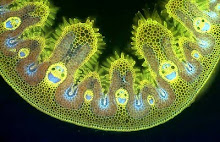“The beauty and fragrance of its flowers make it a welcome guest in our gardens, hedges and arbours”, wrote William Withering in 1776, in his Botanical arrangement of all the Vegetables Naturally growing in Great Britain. For my money none of the cultivated varieties quite match the scent of the wild species, emitting its scent on a warm, still summer night in a country lane. The wild plants seem to have paler, yellower flowers without so much of the purple pigment. Honeysuckle only flowers well if it's in a sunny position and to achieve that it climbs, sometimes to the top of trees, but it's at its best when it climbs through a hedge.

The scent is emitted just as disk falls, attracting moth pollinators, notably hawk-moths that hover with long probosces extended just in front of the flowers, which is why ...
After pollination the berries that form are a great attraction for blackbirds. By one of those happy accidents in gardening, they've perched on our otherwise dull leylandii hedge and voided the seeds in their droppings, so honeysuckle has clambered up through the conifers, which have become a wall of scent on summer evenings.
That in turn has brought this delightful little moth into the garden - the twenty plume moth Alucita hexadactyla, which breeds on the honeysuckle and is strongly attracted to light, setting on the lit wndows of the house after dark. Back in 1776 William Withering noted that several moths visited honeysuckle: “The insects that have been observed to feed on the honeysuckle include the Priver Hawk Moth Sphinx ligustri, the brown feathered moth, Phalaena didactyla, the small bee moth, Sphinx tipuliformis, and the many feathered moth Phalaena hexadactyla”. I think this is the latter, after a change of Latin name.
Some cultivars continue to produce flowers right through until the first frosts - as this one did - but there are also winter-flowering species that bring fragrance to the dullest months of the year.
This is Lonicera x purpusii that begins flowering outside our conservatory door in January. A few sprigs in a vase will scent a whole room.

Given the opportunity, honeysuckle will climb to the tops of small trees, curling around the trunk for support, which is why it acquired the alternative name of woodbine. John Gerard , writing in his Great herball or Generall Historie of Plantes in 1597, described how “Wood-binde or Hony-suckle climeth up aloft, having long slender woody branches........oftentimes winding it selfe so straight and hard about, that it leaveth its print upon those things so wrapped”.

For a closer look at the strangling tendencies of honeysuckle, take a look at this.



















